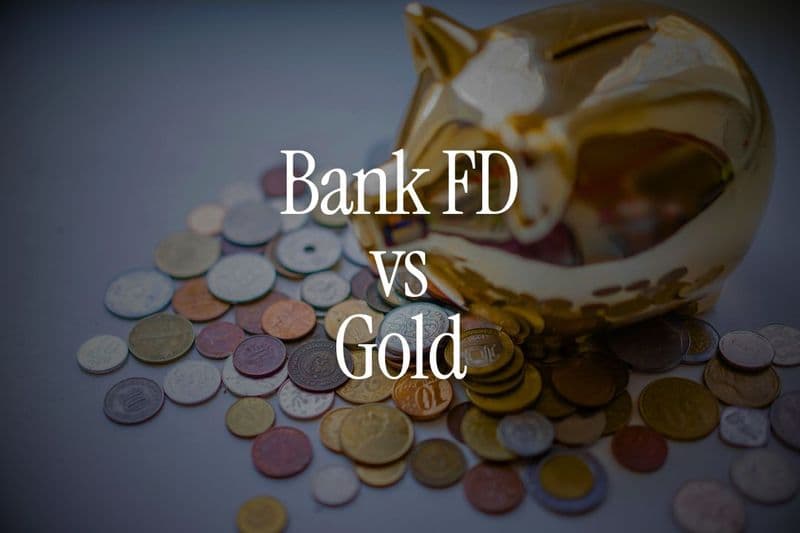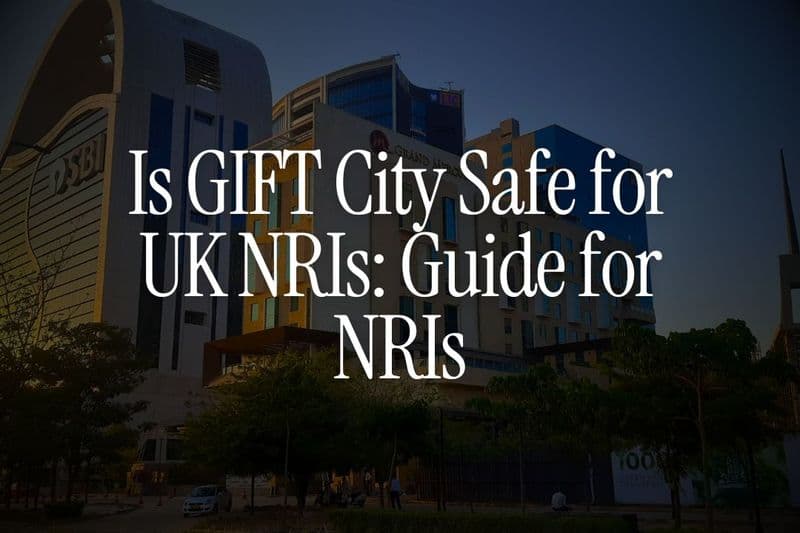
You're sitting in your Dubai office, scrolling through investment options, and that familiar question hits again: Should I park my savings in bank FDs or buy gold?
If you're like most NRIs we work with at Belong, you've probably heard both sides. Your colleague swears by NRE fixed deposits offering 6-7% returns. Your WhatsApp family group is celebrating gold's incredible 60% surge this year.
Your CA is warning about tax complications. And you're left wondering which option actually makes sense for your situation.
As financial advisors who've helped thousands of NRIs navigate exactly this dilemma, we've seen both choices work brilliantly - and fail miserably - depending on the circumstances. The answer isn't universal, but the framework to decide is.
This guide covers every angle: current returns data, tax implications, repatriation rules, storage concerns, and market outlook for 2025. By the end, you'll know exactly which option suits your goals, risk appetite, and timeline.
Plus, we'll introduce you to a third option that many NRIs don't know exists: GIFT City USD fixed deposits that could outperform both.
Ready to settle this debate once and for all?
Current NRI Bank FD Rates: What You Can Expect in November 2025
Let's start with the numbers that matter. As of November 2025, here's what major Indian banks are offering on NRE fixed deposits:
Bank | NRE FD Rate |
|---|---|
7.3% p.a. | |
7.3% p.a. | |
6.50% p.a. | |
Axis Bank | 7.25% p.a. |
7.50% p.a. | |
6.85% | |
7.25% - 7.5% | |
6.65% | |
6.50% - 6.75% |
The good news: Rates have stayed relatively attractive compared to global standards. US CDs are offering around 4.5%, while UAE term deposits hover around 3-4%.
The reality check: These rates are in Indian rupees, which brings currency risk. If the rupee weakens by 3-4% annually (as it has historically), your effective dollar returns drop significantly.
👉 Tip: Check if your bank offers auto-renewal facilities. It saves you from manually tracking maturity dates, especially when managing multiple FDs.
Understanding Your Bank FD Options as an NRI
You have three main types of bank FDs available:
NRE Fixed Deposits
- Funding: Only from foreign currency remittances
- Currency: Indian rupees only
- Tax: Completely tax-free in India
- Repatriation: Principal + interest fully repatriable
- Best for: NRIs who want to bring foreign earnings to India
NRO Fixed Deposits
- Funding: Both Indian and foreign income
- Currency: Indian rupees only
- Tax: 30% TDS on interest (can claim refund via ITR)
- Repatriation: Up to $1 million annually after tax compliance
- Best for: NRIs with Indian rental income or mixed sources
FCNR Fixed Deposits
- Funding: Foreign currency only
- Currency: USD, GBP, EUR (no rupee conversion)
- Tax: Tax-free in India
- Repatriation: Fully repatriable in original currency
- Best for: NRIs wanting to avoid currency risk entirely
For detailed comparison, read our guide on NRE vs NRO vs FCNR deposits.
Gold Investment Options for NRIs: Beyond Physical Gold
Forget what you know about buying gold jewelry from the local souq. As an NRI, you have several sophisticated options to invest in gold:
Physical Gold
- What it is: Coins, bars, jewelry from Indian dealers
- Pros: Tangible asset, cultural significance, easy to understand
- Cons: Storage costs, purity concerns, making charges (8-15%), GST (3%)
- Tax: Short-term gains (under 3 years) taxed as income; long-term at 20% + indexation
Gold ETFs
- What it is: Exchange-traded funds that track gold prices
- Minimum investment: As low as ₹1,000 (roughly price of 0.08 grams)
- Requirements: Demat account linked to NRE/NRO account
- Pros: High liquidity, transparent pricing, no storage issues
- Tax: Same as physical gold but easier to track
Digital Gold
- What it is: Buy gold online, stored in secure vaults
- Platforms: SafeGold, MMTC-PAMP, Augmont Gold
- Minimum investment: ₹1 (yes, one rupee!)
- Pros: Fractional ownership, professional storage, can convert to physical
- Cons: Platform risk, not directly regulated by RBI/SEBI
Gold Mutual Funds
- What it is: Funds that invest in gold ETFs and gold mining companies
- Requirements: No demat account needed
- Pros: Professional management, SIP options available
- Cons: Higher expense ratio, may include equity exposure
Important note: NRIs cannot invest in new Sovereign Gold Bonds (SGBs) as per current regulations, though existing holdings can be maintained.
Returns Showdown: How FDs and Gold Actually Performed
Here's the data that might surprise you:
Gold's Spectacular 2025 Performance
In June 2024, gold was averaging around ₹65,100 per 10 grams. Just 12 months later, in June 2025, the price of gold skyrocketed to ₹1,07,000 per 10 grams. This represents a jaw-dropping ₹41,900 increase in one year-over 60% returns, outpacing stock markets and mutual funds.
As of November 11, 2025, 24-karat gold is trading at ₹12,584 per gram, continuing its upward trajectory driven by global uncertainty and inflation concerns.
Historical Context: 10-Year View
Looking at longer periods provides better perspective:
Period | Gold Returns (CAGR) | Average FD Returns |
|---|---|---|
2015-2025 | ~11-12% | ~6-7% |
2020-2025 | ~15% | ~6.5% |
Last 30 years | ~10% | ~8-9% |
Source: Market data from various financial publications
👉 Tip: Don't get swayed by one exceptional year. Gold's 2025 performance is extraordinary and may not repeat. Base decisions on long-term averages, not recent spikes.
What Drives These Returns?
Gold price factors:
- Global inflation and currency debasement
- Geopolitical tensions (Middle East, Russia-Ukraine)
- Central bank purchases (RBI bought 54.13 tonnes in 2024-25)
- Dollar strength/weakness cycles
FD rate factors:
- RBI repo rate changes (currently at 6.50%)
- Bank liquidity conditions
- Competition among banks for NRI deposits
- Global interest rate environment
Tax Treatment: The Critical Difference for NRIs
This is where the comparison gets complex, and getting it wrong can cost you thousands.
Fixed Deposit Taxation
NRE FDs: Completely tax-free in India. No TDS, no income tax liability. However, you may need to pay tax in your country of residence based on local laws.
NRO FDs: 30% TDS deducted upfront. You can claim refund through ITR filing if your actual tax liability is lower.
FCNR FDs: Tax-free in India, but check local tax implications in UAE/other countries.
Gold Investment Taxation
Short-term gains (sold within 3 years): Taxed as per your income tax slab upto 30%.Long-term gains (held over 3 years): 12.5% tax without indexation benefits.
Example calculation:
- Bought gold for ₹50,000 in 2020
- Sold for ₹80,000 in 2025
- With indexation (assuming 6% inflation): Adjusted cost = ₹67,000
- Taxable gain: ₹13,000 instead of ₹30,000
- Tax saved: ₹3,400
👉 Tip: Keep detailed records of gold purchase dates and prices. Indexation benefits can save significant tax on long-term holdings.
Also Read - DTAA and Capital Gains Tax: The Confusing Bits Explained
DTAA Benefits for NRIs
If you're resident in UAE, you can claim benefits under the India-UAE DTAA to avoid double taxation. This applies to both FD interest and gold gains, but procedures differ.
For comprehensive tax guidance, consider our NRI tax filing services or join our WhatsApp community for peer discussions.
Liquidity and Emergency Access: When You Need Money Fast
Life doesn't wait for investment maturity dates. Here's how both options stack up for emergency access:
Fixed Deposit Liquidity
Premature withdrawal penalties:
- Most banks: 1% penalty on applicable rate
- Some banks: No interest if withdrawn before minimum tenure
- Federal Bank: 1% penalty across all amounts and tenures
Loan against FD:
- Available up to 90% of FD value
- Interest rates: FD rate + 1-2%
- No impact on original FD
- Quick approval (24-48 hours)
Partial withdrawal:
- Available with some banks
- Penalty applies only to withdrawn amount
- Remaining amount continues at original rate
Gold Liquidity
Physical gold:
- Immediate liquidity but involves price negotiation
- May need purity testing
- Making charges not recoverable
- Best rates from organized jewelers
Gold ETFs:
- Instant liquidity during market hours
- Transparent pricing based on spot rates
- T+2 settlement like equity trades
- Can sell partial quantities
Digital gold:
- 24/7 liquidity on most platforms
- Instant credit to bank account
- Small bid-ask spread (typically 2-3%)
- No minimum selling quantity
👉 Tip: For true emergency access, keep a small portion in digital gold or maintain sweep-in facilities with your FD bank account.
Repatriation Rules: Getting Your Money Back Home
Understanding repatriation rules prevents nasty surprises when you need to move money.
Bank FD Repatriation
NRE FDs:
- Principal and interest: Fully repatriable without limits
- No documentation required beyond bank records
- Can be transferred to any global account in your name
NRO FDs:
- Combined limit: $1 million per financial year across all investments
- Requires CA certificate and tax compliance
- Form 15CA/15CB mandatory for large amounts
FCNR FDs:
- Fully repatriable in original foreign currency
- No conversion charges or documentation
- Perfect for those planning to stay abroad long-term
Also Read -NRE vs NRO vs FCNR
Gold Investment Repatriation
From NRE-funded investments:
- Fully repatriable without limits
- Applies to gold ETFs, mutual funds, digital gold
- No additional documentation required
From NRO-funded investments:
- Subject to $1 million annual limit
- Capital gains count toward this limit
- CA certification required for compliance
Physical gold export:
- Technically allowed but practically complex
- Requires customs declaration and documentation
- Import duties in destination country may apply
- Most NRIs sell in India and repatriate proceeds
Inflation Protection: The Real Test
With global inflation concerns rising, let's examine how both options protect purchasing power.
Gold as Inflation Hedge
Gold has historically acted as an excellent hedge against inflation. When there's economic uncertainty, gold prices typically spike as investors seek safety.
Why gold protects against inflation:
- Limited supply with consistent demand
- Central banks worldwide increasing gold reserves
- Inverse correlation with currency values
- Industrial and jewelry demand provides price floor
Recent evidence:
- US inflation peaked at 9% in 2022; gold gained 25% that year
- Indian inflation at 6-7% range; gold outperformed significantly
- Currency debasement globally boosting precious metal appeal
Fixed Deposits and Inflation
Real returns calculation: Current NRE FD rates: 6.5-7% Indian inflation: ~6% Real returns: 0.5-1%
This means FDs barely beat inflation in real terms. Factor in rupee depreciation (typically 2-4% annually against USD), and dollar-based real returns can be negative.
However, FDs provide:
- Guaranteed nominal returns
- Protection against deflation
- Stable income for retirees
- Capital preservation during market crashes
👉 Tip: Use our Rupee vs Dollar tracker to monitor currency trends. If rupee depreciation exceeds FD rates, gold or USD instruments become more attractive.
Storage and Safety Considerations
Physical Gold Storage Challenges
Home storage risks:
- Theft and burglary concerns
- Insurance complications (premiums 1-2% of value annually)
- No coverage for home safes in many policies
- Family disputes over physical possession
Bank locker costs:
- Annual charges: ₹1,500-₹15,000 depending on size and location
- Waiting lists in metro cities
- Limited access hours
- Additional insurance still recommended
Professional vaulting:
- Available through companies like Brink's, G4S
- Cost: 0.5-1% of gold value annually
- High security with insurance coverage
- 24/7 access at some facilities
Digital Gold and ETF Safety
Regulatory protection:
- Gold ETFs: SEBI-regulated fund houses
- Underlying gold stored with approved custodians
- Regular audits and transparency requirements
- ISIN tracking for each unit
Digital gold platforms:
- Varies by platform (SafeGold, MMTC-PAMP are most established)
- Gold stored in RBI-approved vaults
- Insurance coverage by custodians
- Real-time vault audit reports
Fixed Deposit Safety
Deposit insurance: NRE FDs are covered under Deposit Insurance and Credit Guarantee Corporation (DICGC) insurance, providing compensation up to Rs. 5,00,000 per bank.
Bank safety factors:
- SBI, ICICI, HDFC: Government backing or too-big-to-fail status
- Smaller banks: Higher returns but concentration risk
- Systematic risk: All Indian banks face similar regulatory environment
Risk mitigation:
- Spread deposits across multiple banks
- Stay within insurance limits per bank
- Monitor bank financial health through ratings
Currency Risk: The Elephant in the Room
This is perhaps the most underestimated factor affecting NRI investments.
Rupee Depreciation Impact on FDs
Historical INR/USD depreciation:
- 2015: ₹64 per dollar
- 2020: ₹75 per dollar
- 2025: ₹88.70 per dollar (as of November 17)
Average annual depreciation: ~3-4%
Real impact example:
- Invested $10,000 in NRE FD at 7% (₹8.87 lakh at ₹88.70/USD)
- After 3 years: ₹10.88 lakh
- If rupee depreciates to ₹97/USD: $11,218
- Effective USD return: 3.9% annually (vs 7% nominal INR return)
Gold and Currency Risk
Gold as currency hedge:
- Priced globally in USD
- Indian gold prices track international rates
- Rupee depreciation can boost INR gold returns
- Natural hedge for dollar-earning NRIs
Example from 2025: During periods of rupee weakness, gold prices in INR terms rose faster than international gold prices, providing additional returns to Indian investors.
FCNR and USD Deposits: Eliminating Currency Risk
This brings us to an often-overlooked option: FCNR deposits and GIFT City USD fixed deposits.
FCNR deposits:
- Fixed in USD/GBP/EUR
- No conversion to rupees
- Returns: Typically 3-4% in USD
- Zero currency risk
GIFT City USD FDs:
- Even better: 4.5-6% in USD
- Completely tax-free
- IFSCA regulated
- Full repatriation without limits
Investment Minimums and Accessibility
Fixed Deposit Requirements
Minimum investments:
- NRE/NRO FDs: ₹25,000-₹1,00,000 (varies by bank)
- FCNR FDs: $1,000-$2,500 minimum
- GIFT City USD FDs: $1,000 minimum
Documentation needed:
- Valid passport and visa
- NRI bank account (NRE/NRO)
- Address proof from country of residence
- PAN card or Form 60
- Initial funding through proper banking channels
Gold Investment Accessibility
Physical gold:
- No formal minimums but practical minimum: 1 gram (₹12,000+)
- Can buy during India visits
- Online purchase with delivery to India address
Gold ETFs:
- Minimum: Price of 1 unit (typically ₹500-₹1,000)
- Requires demat account
- Can trade in fractions through some platforms
Digital gold:
- Minimum: ₹1-₹100 depending on platform
- No demat account required
- Instant purchase through apps
- SIP facilities available (₹100/month onwards)
👉 Tip: Start small with digital gold to test the platform and process before making larger investments. Most platforms offer ₹100-₹500 welcome bonuses.
Current Market Scenario: November 2025 Perspective
As we write this in November 2025, several factors are shaping the FD vs Gold debate:
Economic Environment
Global factors:
- US Federal Reserve maintaining higher rates
- Ongoing geopolitical tensions in Middle East
- China's economic slowdown affecting global markets
- Inflation concerns persisting across major economies
India-specific factors:
- RBI repo rate stable at 6.50%
- Strong domestic gold demand during festive season
- Government focus on reducing gold imports
- GIFT City expanding its financial services offerings
Gold Market Conditions
Gold rates in India are seeing volatility, with prices fluctuating by ₹9,800 per 100 grams in recent weeks. Current 10 grams gold price stands at ₹1,22,020.
Key drivers for gold in 2025:
- Central bank purchases remain strong
- Wedding season demand in India
- Global uncertainty supporting safe-haven buying
- Technical resistance levels being tested
Banking Sector Outlook
Interest rate expectations:
- RBI likely to hold rates steady through 2025
- Bank credit growth moderating
- NRI deposit competition keeping rates competitive
- Digital banking innovations improving accessibility
Regulatory changes:
- Stricter compliance requirements for NRI accounts
- Enhanced monitoring of large transactions
- GIFT City regulations becoming more NRI-friendly
- DTAA implementation streamlining
GIFT City USD Fixed Deposits: The Third Alternative
Here's where most comparison articles stop, but we'd be doing you a disservice if we didn't mention the game-changer: GIFT City USD fixed deposits.
Why GIFT City Changes Everything
What makes it special:
- Deposits held in USD (no currency conversion)
- Interest rates: 4.5-6% annually in USD
- Completely tax-free (no TDS, no income tax in India)
- Fully repatriable without any limits
- IFSCA regulated (same regulatory standards as Singapore, Hong Kong)
How It Compares
Investment | Currency Risk | Tax | Returns | Liquidity |
|---|---|---|---|---|
INR FDs | High | Varies | 6-7% INR | Moderate |
Gold | Medium | 20-30% | Variable | High |
GIFT City USD FDs | None | Zero | 4.5-6% USD | High |
Real-World Example
Scenario: You have $50,000 to invest for 3 years
Option 1 - NRE FD at 7%:
- Risk: Rupee depreciation could reduce USD returns to 3-4%
- Tax: Nil in India
- Final amount: ~$56,000-58,000 (depends on exchange rate)
Option 2 - Gold ETF:
- Risk: Price volatility, may not repeat 2025 performance
- Tax: 20% long-term capital gains
- Final amount: Highly variable ($45,000-$70,000 range possible)
Option 3 - GIFT City USD FD at 6%:
- Risk: Minimal (regulated banking environment)
- Tax: Completely tax-free
- Final amount: $58,236 guaranteed
Access Through Belong
Currently, GIFT City USD FDs aren't widely available through traditional channels. At Belong, we've partnered with GIFT City banks to make this accessible to NRIs globally.
Our process:
- Complete digital onboarding
- KYC through video verification
- Fund transfer through correspondent banking
- FD certificate issued within 48 hours
Interest in GIFT City options? Download our Belong app or join our WhatsApp community to learn more.
Which Should You Choose? Decision Framework
After analyzing all factors, here's our framework for making the right choice:
Choose Bank FDs If:
You prioritize predictability and are okay with currency risk
- Want guaranteed returns regardless of market conditions
- Planning to return to India within 3-5 years
- Risk-averse personality, can't handle volatility
- Need regular income (quarterly/annual interest payouts)
- Have large amounts to park (₹1 crore+) and want insurance coverage
Best FD strategy:
- Use our FD comparison tool to find highest rates
- Laddering strategy: Invest across different maturities
- Mix NRE and FCNR to balance returns and currency risk
- Keep emergency funds in sweep-in accounts
Choose Gold If:
You believe in long-term wealth creation and can handle volatility
- Investment horizon of 5+ years
- Want hedge against inflation and currency debasement
- Comfortable with price fluctuations
- Believe global uncertainty will persist
- Want diversification beyond fixed-income assets
Best gold strategy:
- Start with digital gold or ETFs for convenience
- SIP approach (₹5,000-₹10,000 monthly) to average out volatility
- Target 10-15% portfolio allocation, not more
- Avoid physical gold unless culturally important
- Track gold investment through apps for tax compliance
Choose GIFT City USD FDs If:
You want the best of both worlds
- Dollar-based returns without currency risk
- Tax-free growth
- Guaranteed returns with USD safety
- Access to innovative financial products
- Future-proofing against rupee volatility
👉 Tip: Most successful NRI investors don't choose one option exclusively. A balanced approach might be 40% GIFT City USD FDs, 30% traditional FDs, 20% gold, and 10% in other investments.
Our Recommendation: The Belong Portfolio Approach
After working with thousands of NRIs, we've found that the most successful approach combines all three options strategically:
The 50-30-20 Strategy
50% GIFT City USD Fixed Deposits
- Core holdings for capital preservation
- Eliminates currency risk completely
- Tax-free growth
- Stable 4.5-6% USD returns
30% Traditional Indian FDs (Mix of NRE/FCNR)
- Higher potential returns (6-7%)
- Diversification across currencies
- Access to Indian banking system
- Liquidity through loan facilities
20% Gold (Digital Gold + ETFs)
- Inflation hedge
- Portfolio diversifier
- Potential for higher long-term returns
- Insurance against economic uncertainty
Adjustments Based on Profile
For conservative investors (age 50+):
- 60% GIFT City, 35% traditional FDs, 5% gold
- Focus on capital preservation and steady income
For aggressive investors (age 30-45):
- 40% GIFT City, 25% traditional FDs, 35% gold
- Higher allocation to growth-oriented assets
For those planning return to India:
- 30% GIFT City, 50% NRE FDs, 20% gold
- Build stronger Indian banking relationships
Frequently Asked Questions
Can NRIs invest in Sovereign Gold Bonds?
No, currently, NRIs cannot make new investments in Sovereign Gold Bonds as per the Foreign Exchange Management Act (FEMA) regulations. However, if you invested while resident in India, you can hold existing bonds until maturity.
What's the minimum investment for NRI gold investment?
It depends on the mode:
- Physical gold: 1 gram (₹12,000+)
- Gold ETFs: 1 unit (~₹500-1,000)
- Digital gold: ₹1-100 depending on platform
- Gold mutual funds: ₹500-1,000 minimum SIP
Are FD rates different for senior citizen NRIs?
No, senior citizen benefits (additional 0.5-1% interest) don't apply to NRI FDs as per most bank policies.
Can I get a loan against gold investments?
Yes:
- Physical gold: Up to 80% value from banks/NBFCs
- Gold ETFs: Margin funding available through some brokers
- Digital gold: Limited loan facilities from select platforms
What happens to my investments if I return to India?
- FDs: NRE/FCNR accounts need to be closed or converted to resident accounts within reasonable time
- Gold: No restrictions, continues as regular investment
- Tax status: Changes from NRI to resident for future income
How do I track gold investment returns for tax purposes?
- Gold ETFs: Demat account statements provide complete transaction history
- Digital gold: Platform provides detailed purchase/sale records
- Physical gold: Maintain purchase invoices and sale receipts
- Use apps like Belong to consolidate investment tracking
The Bottom Line: Smart Money Doesn't Choose Sides
Here's what 12+ years of advising NRIs has taught us: The smartest investors don't put all their eggs in one basket.
Gold's spectacular 2025 performance doesn't guarantee future returns. FD rates might look attractive today but could disappoint if the rupee weakens significantly. And most importantly, your financial goals are unique to your situation.
The winning approach:
- Start with safety: Build a foundation with GIFT City USD FDs or stable bank FDs
- Add growth potential: Include gold allocation for inflation protection
- Diversify intelligently: Spread across different banks, tenures, and gold investment modes
- Review regularly: Rebalance based on changing circumstances and market conditions
- Stay informed: Join communities of fellow NRIs sharing experiences and strategies
Whether you're a software engineer in Dubai planning to buy a home in Bangalore, a doctor in London saving for retirement, or a business owner in New York building wealth for the next generation, the fundamentals remain the same: diversify, stay tax-compliant, and choose options that align with your timeline and risk tolerance.
Ready to build your optimized NRI portfolio?
Download the Belong app to access GIFT City USD FDs, compare live rates across 25+ banks, and use our calculators to model different scenarios. Our SEBI-registered advisors can help create a personalized strategy based on your specific goals.
Join our WhatsApp community of 10,000+ NRIs who share real experiences, market insights, and practical tips on managing finances across borders.
Because smart investing isn't about picking the perfect option-it's about making informed decisions that compound over time.
Disclaimer: This article is for informational purposes only. Investment decisions should be made after consulting with qualified financial advisors. Past performance doesn't guarantee future returns. All rates and figures mentioned are as of November 2025 and subject to change.




